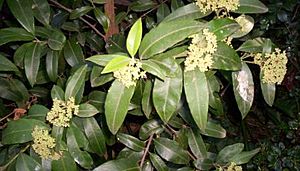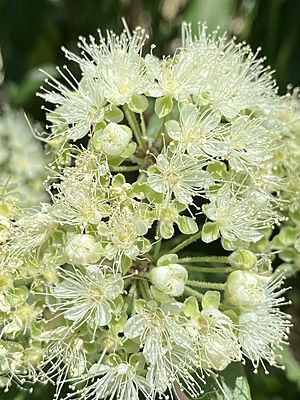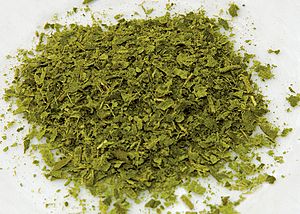Lemon myrtle facts for kids
Quick facts for kids Lemon myrtle |
|
|---|---|
 |
|
| Backhousia citriodora, garden specimen, in flower | |
| Scientific classification | |
| Genus: |
Backhousia
|
| Species: |
citriodora
|
Lemon myrtle, also known as Backhousia citriodora, is a special flowering plant from the Myrtaceae family. It grows naturally in the warm, wet rainforests of central and south-eastern Queensland, Australia. You can find it from Mackay all the way down to Brisbane. People also call it sweet verbena tree or lemon scented ironwood.
Contents
What is Lemon Myrtle?
Lemon myrtle can grow up to 6 meters (about 20 feet) tall, but it's often smaller. Its leaves stay green all year round. They are shiny green, shaped like a spear, and measure about 5 to 12 cm (2 to 5 inches) long. The plant's creamy-white flowers are small, about 5 to 7 mm across. They grow in bunches at the ends of the branches from summer to autumn.
Why is it Called Lemon Myrtle?
The plant was given its scientific name, Backhousia citriodora, in 1853. It was named after an English botanist named James Backhouse.
The common name "lemon myrtle" comes from the strong lemon smell of its crushed leaves. When the native foods industry started selling the leaves for cooking, they shortened the name to "lemon myrtle." Now, this is the most common name for the plant and its products.
Sometimes, people confuse lemon myrtle with "lemon ironbark," which is a different plant called Eucalyptus staigeriana.
Special Oils in Lemon Myrtle
Lemon myrtle has two main types of essential oils inside it:
- Citral type: This is the most common type. It's grown in Australia for its amazing lemon flavouring and essential oil. The oil from this plant is super rich in citral, usually 90–98%. It's one of the best natural sources of citral!
- Citronellal type: This type is not as common. Its oil can be used to keep insects away.
How People Use Lemon Myrtle
Indigenous Australians have used lemon myrtle for a very long time. They used it in their cooking and as a healing plant. The oil from lemon myrtle has a very pure citral content, even higher than lemongrass. Many people think it has a "cleaner and sweeter" smell than other plants that contain citral.
Cooking with Lemon Myrtle
Lemon myrtle is one of the most popular bushfoods from Australia. Some even call it the "Queen of the lemon herbs." You can use the dried leaves as flakes or as a special flavor essence that lasts a long time.
It's used in many ways, like:
- Adding lemon myrtle flakes to shortbread cookies.
- Flavoring pasta.
- Baking whole leaves with fish.
- Infusing it into macadamia or other vegetable oils.
- Making delicious tea blends.
You can also use lemon myrtle to add lemon flavor to milk-based foods like cheesecake, lemon ice-cream, and sorbet. Unlike lemon fruit, it won't make milk curdle because it's not as acidic.
The dried leaves of lemon myrtle also have properties that can help protect your body's cells.
Lemon Myrtle for Health
The essential oil from lemon myrtle has properties that can fight against tiny germs like bacteria. However, the pure oil is very strong and can be harmful to human cells if not diluted. When it's diluted to about 1%, it's considered safe for skin.
Scientists have studied lemon myrtle oil as a treatment for skin problems caused by a virus called molluscum contagiosum. This disease affects children and people with weakened immune systems. In one study, nine out of sixteen patients who used a 10% lemon myrtle oil solution showed great improvement.
A study in 2003 found that lemon myrtle could be useful as an antiseptic (to clean wounds), a surface cleaner, or even as an additive to food to stop germs from growing. Because of these benefits, the oil is a popular ingredient in many health and cleaning products, such as soaps, lotions, and shampoos.
Growing Lemon Myrtle
Lemon myrtle is a popular plant to grow in gardens. It can grow in warm, tropical areas and even in slightly cooler places if protected from frost when it's young. In gardens, it usually doesn't grow taller than about 5 meters (16 feet) and has many dense leaves. Gardeners love it because its leaves and flowers smell wonderfully like lemon.
Lemon myrtle is a tough plant that can grow in most soils, as long as they drain well. It might grow slowly at first, but it responds well to slow-release fertilizers.
When grown from seeds, young lemon myrtle plants go through a bushy, slow-growing stage before developing a main trunk. You can also grow lemon myrtle from cuttings (pieces of the plant). This method helps the plant grow faster and ensures that new plants are exactly like the parent plant.
In large farms, lemon myrtle is often kept as a shrub by regularly trimming the top and sides. This helps with harvesting the leaves. It's important to leave some lower branches when pruning to keep the plant healthy. The harvested leaves are then dried to be used as a spice or distilled to get the essential oil.
Most commercial lemon myrtle is grown in Queensland and the northern coast of New South Wales, Australia.
A study in 2009 suggested that drying lemon myrtle leaves at higher temperatures can increase their citral content, but it might also change the color of the leaves.
Myrtle Rust Threat
A serious fungal disease called myrtle rust (Uredo rangelii) was found in lemon myrtle farms in January 2011. Myrtle rust can badly damage new growth on the plants and is a threat to lemon myrtle production. Scientists are working on ways to control this disease.
Lemon Myrtle Through History
- Before 1788: Indigenous Australians used B.citriodora for medicine and to flavor their food.
- 1853: The plant was given its scientific name, Backhousia citriodora, by botanist Ferdinand von Mueller. He named the genus after his friend, James Backhouse, a botanist and missionary.
- 1888: A scientist named Bertram separated citral from B.citriodora oil. Companies like Schimmel & Co. in Germany thought the essential oil had a promising future.
- Early 1900s: B.citriodora oil was produced on a small scale around Eumundi, Queensland.
- 1920s: Scientists A. R. Penfold and R.Grant discovered that steam-distilled B.citriodora oil had properties that could fight germs.
- 1940s: During World War II, the Tarax Co. used B.citriodora oil as a lemon flavouring.
- 1950s: Some oil production continued in the Maryborough and Miriam Vale areas, but the small industry eventually slowed down.
- 1989: Peter Hardwick started looking into B.citriodora as a possible leaf spice and commercial crop.
- 1990: Restaurants and food makers started getting dried B.citriodora leaves from suppliers like Vic Cherikoff.
- 1991: The first B.citriodora farm was set up by Dennis Archer and Rosemary Cullen-Archer, leading to commercial oil supply in 1993.
- 1997: Large B.citriodora farms were started in north Queensland.
- Late 1990s: B.citriodora began to be sold internationally for many uses, including flavouring, cosmetics, and products that fight germs.
- 2001: Quality standards for B.citriodora oil were set by The Essential Oils Unit and Standards Australia.
- 2004: A detailed book about B.citriodora was published.
- 2010: Lemon myrtle became very popular in London after chef Jamie Oliver talked about it on his TV show.
See also
 In Spanish: Mirto limón para niños
In Spanish: Mirto limón para niños




